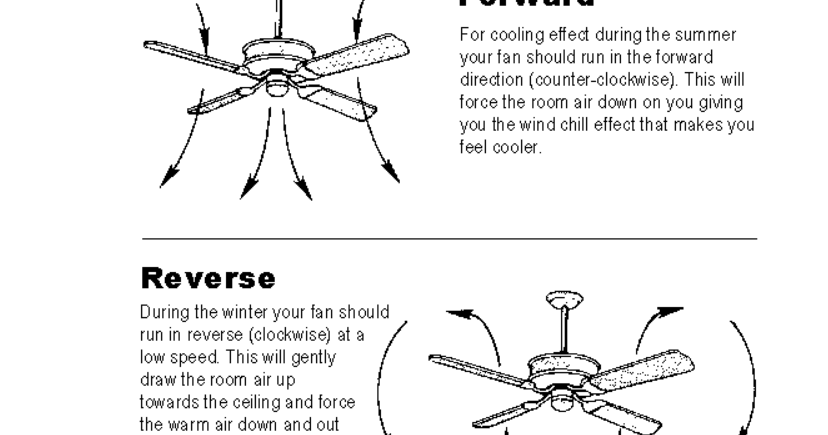
This is one of the easiest ways you can save money and energy in your home. Then you can enjoy a breeze instead of having to turn your thermostat down! This will force the warm air near the ceiling down into your living space which will save energy and money because you are actually using the warm air up there instead of having to turn your thermostat up!ĭuring the warmer months, having the blades circulating in a counter clockwise motion will create a nice breeze which will make you feel cooler. In the cooler months, having the blades circulating in a clockwise direction will create an updraft. In the winter, you actually want that switch in the up position, and in the summer, it should be in the down position as shown above. Reversing your fan, to a clockwise direction, creates a gentle updraft, recirculating heat down. The airflow directly underneath the ceiling fan should push down, creating a wind-chill effect, which is going to make you feel cool. The setting for summer will create a large wind. Which way should a fan spin to cool During the summer, use your ceiling fan in the counterclockwise direction. If you’re still unsure about whether or not your ceiling fan is spinning in the correct direction, try both settings. That means that if you’re looking up at a ceiling fan, the blades should be spinning to the left. See that little switch? It changes the direction of the blade rotation. During summer, your ceiling fans should spin in a counter-clockwise rotation. Apart from lower velocity fan must be able to. This spin direction makes the blades create an updraft, sucking cold air up and forcing the room’s warmest air (remember, heat rises) downward toward the room’s occupants. In the winter, the fan should spin the opposite direction: clockwise. You may be thinking.hmmm? What? Why would you even have your ceiling fan on if it is cold outside? Well, friends, I use my ceiling fan all year round.I just switch the rotation direction of the blades depending on which season it is. Lower air velocity can be achieved by circulating fan in clockwise direction when looked from bottom of the fan. Summer Counterclockwise Winter Clockwise.

If those blades are moving clockwise, that’s the winter heat setting. Imagine the spinning blades are the arms of a clock. To help understand, lie on your back looking up at your fan (enjoy the breeze while you’re there). I looked up and realized that my ceiling fan was on, but not moving in the right direction. Counter-clockwise is the direction to use for summer. As I was walking though my living room this morning, I got a sudden chill. If you're hoping to chill out this summer without turning on the A/C, check out some of our other tips for staying cool here.It's getting chilly here in Kentucky, and we have already switched the heat on. Running a ceiling fan allows you to raise the setting of your air conditioner approximately 4☏ without noticing a difference in comfort, according to the U.S. In either season, turning on your ceiling fan can help you save energy by limiting the amount of heating and air conditioning you use, without having to sacrifice your comfort. Make sure that the fan is completely shut off and has stopped spinning, then grab a chair or ladder and find the switch, which is often located near the pull cord. The direction makes a huge difference in how the fan moves air. For most fans, you can change the direction of the spin using a switch on the fan's motor. Fan blades can spin both clockwise and counterclockwise. Some newer fans also let you switch the spin direction by remote control, but if that's not the case for your fan, it's still a relatively easy fix. A low-speed clockwise spin can create an updraft in the room that forces warm air down from the ceiling, making you feel a little more toasty below. The clockwise setting on a fan helps your room feel warmer rather than cooling it down. Running the fan clockwise at low speed creates an updraft that drives the warm. Keep the fan speed set on low to generate the desired air circulation and also to avoid causing a cooling wind that makes the room colder. If you don't feel that air movement while standing beneath your ceiling fan, it's probably spinning the wrong way. Which Way Should Fan Spin in Winter During winter temperatures, keep your ceiling fan set to spin clockwise (left to right). But if you've noticed that your fan works better on cold days than on hot ones, you may just have it on the wrong setting, as the Spark Energy blog suggests.Īccording to Energy Star, ceiling fans should be set to spin counterclockwise in the summer, creating a cool downward breeze. They can also be used in the winter to circulate warm air from the ceiling. Ceiling fans aren't just for hot summer days.


 0 kommentar(er)
0 kommentar(er)
